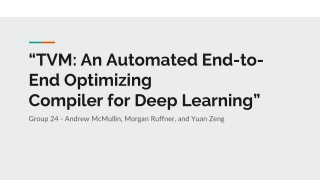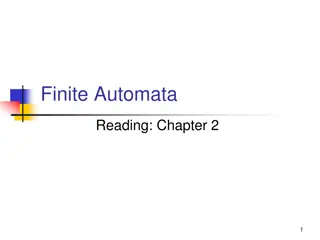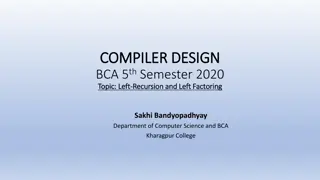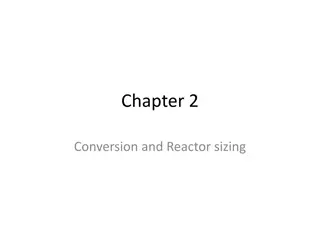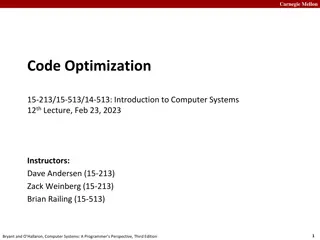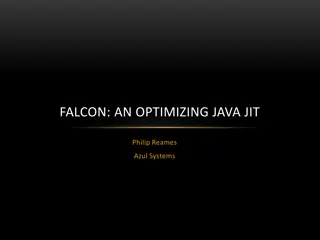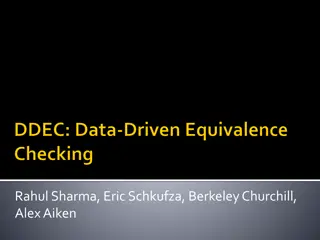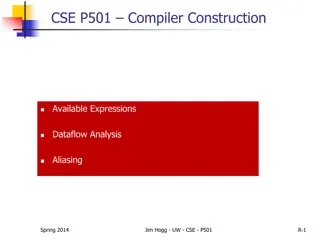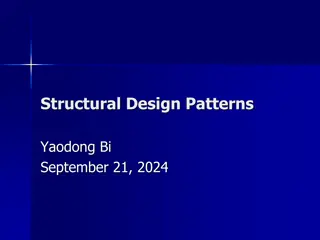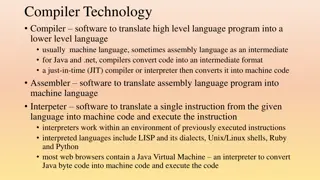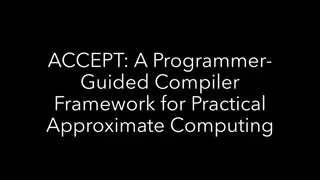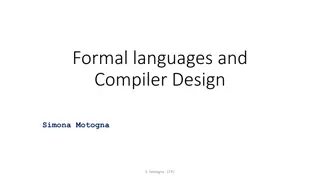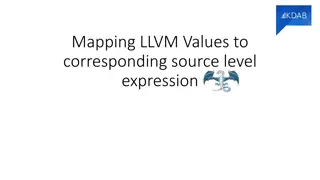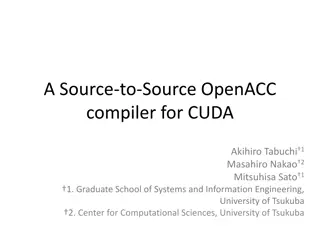Compiler Data Structures and NFA to DFA Conversion
Compiler data structures play a crucial role in the compilation process, handling lexical analysis to code generation. Understanding the conversion from non-deterministic finite automata (NFA) to deterministic finite automata (DFA) is essential for efficient language processing and optimization.
Uploaded on Sep 21, 2024 | 0 Views
Download Presentation

Please find below an Image/Link to download the presentation.
The content on the website is provided AS IS for your information and personal use only. It may not be sold, licensed, or shared on other websites without obtaining consent from the author. Download presentation by click this link. If you encounter any issues during the download, it is possible that the publisher has removed the file from their server.
E N D
Presentation Transcript
NFA to DFA: Approach In: NFA N Out: DFA D Method: Construct transition table Dtran (a.k.a. the "move function"). Each DFA state is a set of NFA states. Dtran simulates in parallel all possible moves N can make on a given string. Operations to keep track of sets of NFA states: _closure(s) set of states reachable from state s via _closure(T) set of states reachable from any state in set T via move(T,a) set of states to which there is an NFA transition from states in T on symbol a
NFA to DFA Algorithm Dstates := { _closure(start_state)} while T := unmarked_member(Dstates) do { mark(T) for each input symbol a do { U := _closure(move(T,a)) if not member(Dstates, U) then insert(Dstates, U) Dtran[T,a] := U } }
Lexical Tables Memory management components of a compiler interact with several phases of compilation, starting with lexical analysis. Efficient storage becomes helpful on large input files. There is colossal duplication in lexical data: variable names, strings and other literal values What token type to use may depend on previous declarations (Why?) A hash table can avoid this duplication, or help decide what token type to use. The software engineering design pattern is called the "flyweight".
Literal Table Example id [a-zA-Z_][a-zA-Z_0-9]* num [0-9]+(\.[0-9]+)? %% [ \t\n] { /* discard */ } if { return IF; } then { return THEN; } else { return ELSE; } {id} { yylval.id = install_id(); return ID; } {num} { yylval.num = install_num(); return NUMBER; } "<" { yylval.op = LT; return RELOP; } ">" { yylval.op = GT; return RELOP; } %% install_id() { /* insert yytext into the literal table */ } install_num() { /* insert binary # computed from yytext into table */ }
Major Compiler Data Structures Token integer category, lexeme, line #, column #, filename... leaves in a tree structure: syntax tree grammar information about a sequence of tokens. leaves contain lexical information (tokens). internal nodes contain grammar rules and pointers to tree nodes. symbol table variable names data types used in semantic analysis address, or constant value used in code generation intermediate & final code link lists or graphs sequences of machine instructions, register use information
Construct Tokens Inside yylex() Can t do the malloc/new inside main() Next compiler phase, main() calls yyparse() which calls yylex() yylex() has to do all of its own work Stick pointer to token struct in a global Code in parser will insert it as leaf in a tree
Things to Look for in HW Adding reserved words is trivial. clex.l was for C add some of the C++ reserved words for 120++. any new data types (bool) and literal constants? New literals can require new nontrivial regular expressions in your lex file. bugs in the clex.l file you were given? check the regular expressions for literal constants close scrutiny and painstaking attention to detail...


